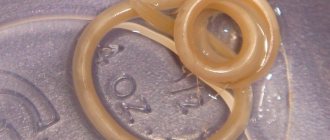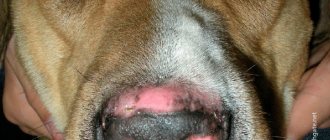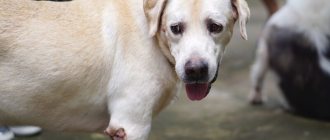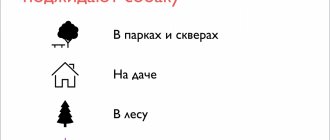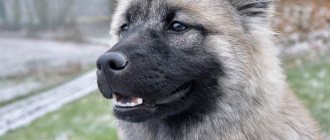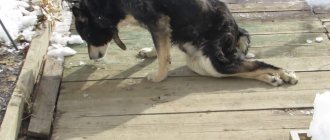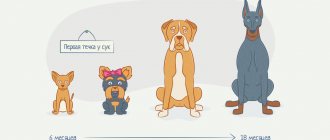What is rhinitis?
Rhinitis is an inflammation of the mucous membranes of the nose; it can be either an independent disease or a sign of other pathologies, for example, infection or allergies. There are several types of disease:
- Spicy. The symptoms are pronounced, the condition occurs against the background of infection with a virus or bacteria.
- Chronic. Appears as a consequence of prolonged exposure to adverse environmental factors or as a complication of the acute form.
- Vasomotor. The reaction occurs at the level of reflexes.
- Allergic. The mucous membranes are sensitive to allergens in the external environment (pollen, dust, etc.).
Many people put rhinitis in dogs and a runny nose on the same level, but in fact, nasal discharge is only a symptom of the disease. This type of disease is called catarrhal rhinitis.
Causes of runny nose in dogs
The condition occurs for many reasons, most of them are similar to human ones:
- Cold. Animals, just like people, react to hypothermia and drafts. If the dog walked for a long time in bad weather, suddenly left a hot apartment into the cold, slept on a cold floor, the body’s thermoregulation is disrupted, a runny nose, fever, sometimes sneezing, coughing, and fever occur.
- Infection or virus infection. In this case, the first two to three days the discharge will be abundant, liquid and transparent. Next, the green (yellow) snot will become thicker, and the dog will begin to grunt. Your pet may also suffer from conjunctivitis, stool disorders, and vomiting.
- Allergic rhinitis is a reaction of the immune system to an irritant. Most often it is dust, pollen, specific scents, chemicals or shampoos. Clear snot flows, accompanied by redness of the eyes, coughing, and sneezing. Diarrhea and difficulty breathing occur less frequently.
- Aggressive odors can cause a short-term runny nose. The pet will scratch its face with its paws, sneeze, and turn away.
- Foreign object in the respiratory tract. Dogs explore the world through their sense of smell, so it's not surprising that they might accidentally inhale a small object. The dog will try to get rid of it, sneezing, rubbing his nose, shaking his head. Discharge will be observed only from one nostril; if it is damaged, blood may be present in the mucus.
- The presence of neoplasms in the nasal passages (polyps, cysts, tumors). In this case, breathing is difficult, the animal will sniffle, grunt, breathe through its mouth, often rub its face, and pain will appear.
- Mechanical damage, congenital pathologies (fracture of the nose or jaw, cleft palate).
Rhinitis is often caused by weakened immunity.
The body's protective reactions are reduced in young and elderly individuals, pets suffering from kidney, liver or heart diseases, endocrine and genitourinary systems, infection with fleas or worms. Breeds with a flattened muzzle, such as Shar-Peis and Pugs, are more likely to suffer from a runny nose.
Symptoms of rhinitis
While describing the possible causes of the problem, we briefly mentioned the signs of a particular disease. Symptoms may vary, but general features of the disease can be identified:
- presence of nasal discharge (intensity and consistency vary);
- difficulty breathing (you can hear wheezing, snoring in your sleep);
- the dog constantly tries to help itself by touching its nose with its paws;
- sneezing;
- deterioration of smell.
Apathy, poor appetite, and tearfulness also often appear. With a prolonged runny nose, crusts form on the nose. Possible increased body temperature, diarrhea, nausea.
Causes
There are many reasons why rhinitis develops. The condition may be due to allergies, injury, or infection.
Allergic reaction
Animals may suffer from allergies to pollen, household chemicals, and flea saliva. It is important for the owner to remember when the first signs of ill health appeared and what they are associated with.
Irritation of mucous membranes
Strong odors and smoke cause your pet to produce mucus from the nose. The condition is accompanied by lacrimation, sneezing, and coughing.
Foreign body
The entry of solid objects into the nasal cavity leads to injury to the mucous membrane.
The main symptom is clear discharge from only one nostril.
Weakened immunity
The immune system cannot cope with the onslaught of viruses and infections. After short walks the dog begins to get sick.
Neoplasms
Polyps, nodes, cysts, papillomas provoke injuries to the nasal passages and mucous membranes. The appearance of tumors in the nose is always accompanied by sputum production.
Infectious diseases
Bacteria and infections provoke the development of rhinitis. Its first symptom is sneezing and discharge. If left untreated, a runny nose develops into a chronic one .
Diseases of teeth and gums
Inflammation of the oral mucosa and caries provoke the development of infection.
It enters the nasopharynx and leads to rhinitis.
Hypothermia
If an animal spends a long time in the cold, hypothermia and a runny nose may occur. In this case, nasal discharge is accompanied by increased body temperature, chills, and weakness.
How to treat runny nose in dogs at home?
You can treat snot in a dog at home, but a doctor must still prescribe it. He will determine the cause of rhinitis, prescribe medications in accordance with it, and, if necessary, take additional tests. Before the doctor arrives, the owner can do the following:
- A flashlight will be a great help to examine your pet. Assess the presence of discharge, its color and consistency, and intensity. Observe your dog for other symptoms. You will tell the doctor about all this.
- Clear your nose of mucus and crusts. To do this, wrap gauze or a cotton pad around your finger and, if necessary, moisten it with warm water.
- You can give your dog a chamomile decoction or treat the nasal passages with it. Taking an infusion of the herb internally soothes, applying it to the mucous membranes relieves itching and has an antiseptic effect.
- Make sure that the animal does not aggravate its condition by being in a draft or frost. Walking your dog when you have a runny nose is minimal.
- Offer your pet to drink more, preferably warm water. The food remains familiar.
The doctor will prescribe medication. Depending on the provoking factor, it may be necessary to exclude the allergen from the diet or the external environment, take antihistamines, remove a foreign body from the passages, or surgically remove tumors. But in most cases, a runny nose is caused by a cold, then nasal medications, warming and rinsing the sinuses are most often used to relieve the symptom.
Nasal drops
The most famous nasal drops for a runny nose for dogs are Maxidin. Doctors allow you to give them yourself, the main thing is to take into account the instructions for use. The drug has an antiviral and immunomodulatory effect. Used in the treatment of plague, parvovirus, enteritis, and helminthiasis. They help with skin diseases and are often prescribed as a preventive measure. If you start giving Maxidin at the first appearance of snot, you can prevent the spread of infection. Drop the solution 2 drops 3 times a day.
Another well-known remedy is Anandin. An intranasal drug used to treat rhinitis and conjunctivitis; accordingly, it should be instilled into the nose or eyes, depending on the problem. For a runny nose, it is recommended to use the product three times a day, the dose depends on the weight of the animal, ranging from 1 to 4 drops. Long-term therapy is addictive, so the duration of the course is no more than 14 days.
The use of human drops such as Naphthyzin or Sanorin is strictly prohibited. In the chronic form of the disease, you can drip menthol oil.
Warming up
One of the effective methods of facilitating an animal's breathing is warming up. You need to take a sock or scarf, heat salt or sand in a dry frying pan, pour it into the fabric. The compress is applied to the bridge of the nose for 3-4 minutes. Remember, it is better to do short-term but frequent procedures. If home treatment is not enough, physical therapy can be provided through a veterinary clinic.
Do not overheat the salt; too hot a product can cause burns.
Washing
It is necessary to rinse your dog's nose when he has a runny nose. Firstly, it cleanses the airways and removes mucus. Secondly, it is a preventive measure against the spread of infection. You can use pharmaceutical remedies or traditional methods, including:
- Soda solution, prepared at the rate of 1 tbsp. water for 1 tsp. sodium carbonate. The liquid should be warm. On the advice of a doctor, you can add a few drops of iodine to the mixture.
- Infusions of chamomile, St. John's wort, coltsfoot, violet and calendula are used. They soothe and disinfect mucous membranes. Add 1 tsp to a glass of boiling water. herbs, let it brew, cool and strain the solution.
- Beetroot juice for instillation is diluted with water in a 1:1 ratio.
- Some owners use onion juice to treat a runny nose, but you need to be careful with it; sensitive mucous membranes may become irritated. The secretion of one vegetable is squeezed out and mixed with water in equal parts. Cotton swabs are soaked in the solution and inserted into the nostrils for 10-15 minutes. The duration of treatment depends on the severity of symptoms.
- It is allowed to use sea water for washing: Aqua Maris, Aqualor, Dolphin.
- On the advice of a doctor, a solution of furatsilin (0.1%) is used.
Whatever medicine or remedy you choose, first assess the dog's condition. If the snot flows, you can limit yourself to simple rinsing. If your nose is stuffy or a lot of crusts have formed, you must first soften them. To do this, use turundas with petroleum jelly, glycerin, and 3% hydrogen peroxide. Oxolinic ointment has a softening and antiseptic effect; it is effectively used at the first signs of a cold.
It is allowed to use Evamenol ointment. Its composition is completely natural: menthol, eucalyptus oil, petroleum jelly. It is most convenient to apply the product with cotton swabs; keep in mind that dogs do not like such procedures, so it will be good if someone can hold the dog.
In the chronic form of the disease, on the contrary, it is necessary to dry the skin around the nose. For this purpose, special powders are prescribed, including streptocide powder.
Treatment of a dog with rhinitis
Treatment of a dog with rhinitis always begins with eliminating the causes of its occurrence. Without this, there is no point in using nasal drops or antibiotics. Agree, if your pet has allergies, then antibiotics will not help. And if the reason lay in infection, then simple drops will not bring much benefit either. Therefore, it is necessary to treat your dog for rhinitis comprehensively.
Recommendations for treatment at home
- You must start with improving living conditions and diet. These measures are a small but necessary step towards the recovery of the mustache. No drafts, cold, dampness. And you shouldn’t walk outside for a long time. If the weather is calm and the sun is warm, then you can take a normal walk. The main thing is to protect your pet from hypothermia and sudden changes in temperature.
Enrich your diet with vitamins and minerals. Normalize their content (and not only for the period of treatment). Pay attention to vitamins A and C.
- If your pet has been diagnosed with catarrhal rhinitis, then frequent instillation of special drops or decoctions of medicinal herbs (coltsfoot, chamomile, string) will help.
- If a dog has lobar, purulent or follicular rhinitis, the use of antibiotics is mandatory (nasal drops are prescribed for acute and chronic disease). With these types of inflammation, pathogenic microflora cannot be avoided. Therefore, antibiotics are always prescribed.
- If rhinitis is purulent (and even chronic), it is best to do a sensitivity test to the active substance. This way you can find out as accurately as possible which drugs will be most effective in the case of your pet.
- If there are crusts in the nose that interfere with breathing, then they need to be softened. To do this, use a 3 percent peroxide solution (just a couple of drops).
- Is your dog's nose cracked? Vaseline will help. Gently massage onto skin to hydrate and soften it. The cracks will heal faster, and no new ones will appear. It won't hurt your pet as much.
- But sometimes, on the contrary, it is necessary to dry the skin (if the contents of the nose are constantly flowing). To do this, use streptocide powder (you can crush tablets with it). This will dry out the skin and prevent the infection from multiplying on the “soaked” skin.
It is forbidden to use human drops to treat a dog.
with acute rhinitis (or chronic). Many substances are toxic to your pet. The only exception is pinosol.
Prevention
The most important prevention of rhinitis in a dog is to prevent the causes from acting! Do not overcool your pet, feed it correctly and in a balanced manner, and avoid drafts. Vaccinate your dog on time, and also exclude all contacts with possible allergens. Do not self-medicate under any circumstances. And don't leave it to chance. After all, if the cause is not found and eliminated, your pet’s sniffles may not go away for months!
If you still have questions about rhinitis in dogs - how to treat them and others, ask in the comments, we will try to answer!
What to do if your dog grunts?
If there are no obvious symptoms of a cold or allergy, but the dog sniffles or snores in its sleep, it is necessary to find out the cause of the phenomenon and begin appropriate treatment:
- Polyps and other neoplasms. Small growths may not be noticed; only difficulty breathing will indicate their presence. When large tumors appear, the teeth will begin to loosen, frequent nosebleeds will occur, and in the later stages the muzzle will become deformed. The problem cannot be solved with pills; surgical intervention is necessary.
- Adenovirus is one of the common and dangerous infections, one of the symptoms of which is rhinitis. The discharge will be cloudy in color and a frequent cough will begin. The disease is only combated by antibiotics and supportive care.
- Allergic rhinitis can only be treated under medical supervision. If the allergen can be excluded, this must be done; if not, for example, a reaction to pollen occurs, the veterinarian will prescribe a course of treatment with antihistamines. In this case, the owner will only need to rinse the pet’s nose.
The occurrence of rhinitis is a signal to the breeder that the pet’s immune system is weakened and needs to be strengthened. Often in dogs of small breeds the body’s protective properties do not cope. They need to be stimulated with vitamins (A, E, C, group B), the veterinarian can additionally prescribe immunomodulators (Immunofan, Immunal, Cycloferon, Gamavit).
Video: how to treat a runny nose (rhinitis) and snot in a dog at home?
Washing technique at home
The technique for this procedure is similar to washing a cat's nose. So, if you can do it with a cat, you can probably do it with a dog. The main thing is more self-confidence, patience and calmness.
You need to arm yourself with warm boiled water and napkins. The size of the napkins should be chosen based on the size of the dog. The material must be soft and hygroscopic. The ideal option is a clean cotton rag. Disposable viscose wipes are also suitable. It is better not to use gauze wipes or tampons, because... they can injure the nasal mucosa and irritated skin of the earlobe. You will need cotton swabs and, possibly, a baby aspirator to remove mucus from the nasal passages. It all depends on how abundant the discharge is.
Rinse the dog's nose with a special spray
Is it possible to use furatsilin and saline solution?
What solution do we use to rinse the nasal passages? For this, saline solution (0.9%), furatsilin solution, official chlorhexidine solution (1%) may be suitable. Furacilin is best used for purulent discharge.
Any manipulation should begin with correct fixation of the “patient”. If the dog calmly tolerates such procedures, then this, of course, will make the task easier, but such pets are rare.
For convenience, the owner should sit down on a chair, sit the dog with his back turned to him (with the back of his head facing him), fixing his head between his knees. It is also convenient to help hold your head with your left hand (for a right-handed person). But much in this matter depends on how large the dog is and how well trained it is.
First, with napkins soaked in warm boiled water, remove all discharge from the nostrils that flows out, soak and remove dried crusts.
Instead of water, you can use a warm solution of furatsilin. It is not difficult to prepare, but it is time-consuming - 1 tablet per glass of hot water, then you need to wait 1.5-2 hours for the tablet to completely dissolve. To speed up the process, it is better to crush the tablet first.
Then, you can use an aspirator and carefully try to remove accumulated mucus from the nasal passages.
After the aspirator, it makes sense to clean up the remaining fragments of crusts and mucus with cotton swabs dipped in warm boiled water or a furatsilin solution.
After the procedure
After cleaning the nasal passages, before administering medications prescribed by a veterinarian, it would be a good idea to drip a generous amount of saline into each nostril. The volume depends on the size of the dog (length of the nasal passages) and can vary from 1 ml to 5 ml per nostril. You can use 1% chlorhexidine solution for this procedure (sold ready-made at the pharmacy), but you should remember that it has bactericidal properties, unlike saline solution, which means it will dry out the nasal mucosa.
After such rinsing, it will be possible to instill/put medicines into the nose.
For infectious diseases, nasal rinsing alone is not enough for complete treatment. This means that even if this procedure is performed in a timely manner and according to all the rules, recovery will occur only if all the doctor’s prescriptions are followed, and not just this.
Sometimes, veterinarians in critical situations use such drugs, but only “for children”, with a concentration of the active substance of no more than 0.05%. Ideally – 0.025% and 0.01% (for children from 1 month)
Prevention of runny nose in dogs
In most cases, inflammation of the mucous membranes of the nose is caused by a cold. It can be easily prevented if you follow these recommendations:
- Provide the animal with proper care: a balanced diet and sufficient exercise. Remember that if you feed your pet natural food, it is better to give additional mineral complexes. If you prefer dry food, buy professional brands. Always consider your friend's breed; Jack Russell Terriers and Corgis require different levels of exercise.
- Walk your animal regularly (at least 2 times a day), with the exception of bad weather.
- Avoid hypothermia at home and outside. In the apartment, the dog should have a bed; it is located in a place protected from drafts. The dog is not taken for a walk after bathing; in the cold season, insulated overalls are worn.
- Hardening helps strengthen the immune system and improves the general condition of the body. The main thing is to gradually increase the time you walk in the cold.
- Do not ignore annual vaccinations, they strengthen the immune system and protect against the most dangerous infections. It is also advisable to take your dog to the veterinarian once a year and undergo general tests.
- A runny nose can be a symptom of a viral disease that was contracted from another animal. Try to protect your pet from contact with sick individuals.
Following these recommendations will make your pet's body stronger. If you are all faced with rhinitis, do not delay treatment, do not allow the disease to progress.
